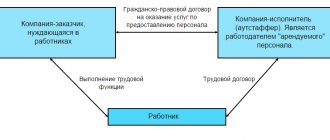What types of remuneration systems are there and when are they used?
For each group of workers in an enterprise and even for each specific person, the payment system for performing labor functions may vary. Let us highlight the following types of such systems:
- Time-based - an employee’s payment is directly dependent on the time he or she works. In this case, the employee is set an hourly or tariff rate and salary.
- Piecework - the amount of earnings depends on the amount of work performed. Piece rates must be approved here.
- Commission - when it is established, the employee receives a commission (percentage) on a certain indicator, for example, 5% of the store’s daily revenue.
- Variable salary system - an employee's salary is subject to periodic review, for example once a quarter or month. Such a review can be influenced by such an indicator as the completion of the planned amount of work.
- Chord - involves establishing a relationship between the amount of an employee’s salary and the package of work he performs in accordance with the chord assignment for a specific period.
The payment system is approved either in a local regulatory act at the enterprise, for example in the regulations on remuneration, or in a collective or labor agreement.
If you have access to ConsultantPlus, go to the Ready Solution and find out the features of payroll calculation in each wage system. If you do not have access to the legal system, get a trial demo access for free.
Calculation of the minimum hourly wage in 2021
This indicator is not formally specified in the legislation. But calculations can always be linked to the current minimum wage. For this we need the following data:
- Minimum wage: from 05/01/2018 for St. Petersburg it is 17,000 rubles (in accordance with regional agreement dated 09/20/2017 No. 323/17-C).
- Maximum number of working hours per month. To do this, let's turn to the production calendar. Russians work the most in August and October - 184 hours.
- Let's divide the first indicator by the second and get the minimum hourly rate - 92.39 rubles.
The amount differs depending on the region. In general, the minimum wage in Russia is 11,163 rubles. This means that the minimum possible hourly rate in the country is 60.67 rubles.
What is hourly wages and what are its forms?
The hourly wage system is one of the varieties of the time-based system. Here, wages are calculated depending on the amount of time worked - hours - and the established hourly rate.
NOTE! With a time-based system, salaries or tariff rates may also be set, but these are usually tied to a month.
At enterprises, depending on the specifics of production and other factors, the hourly system can take the following forms:
- Standard hourly rate - when a fixed rate is set for one hour of work. At the same time, the volume and quality of work do not affect wages. This form is typical for the positions of security guard, operator, administrator, etc.
- Premium hourly wage - here the volume and quality of work performed will affect wages. That is, the time worked is paid and to this amount is added the amount of the bonus, the amount of which must be indicated in the regulations on remuneration, employment contract or in other regulations or agreements.
- Standardized hourly rate - in this case, in addition to the hourly rate, an additional payment is guaranteed for strict compliance with the conditions established by the employer. This form is convenient to use when exceeding production standards is undesirable.
Due to the 2021 coronavirus pandemic, the payment procedure has changed in a number of cases. We wrote more about this in the material “New in Payroll in 2020”.
New changes to the minimum wage: prerequisites
The minimum wage is set annually and is equal to the subsistence level of the working-age population for the 2nd quarter of last year. In 2020, this figure is 12,130 rubles. (Federal Law dated December 27, 2019 No. 463-FZ). Regions can set their own minimum wage, which cannot be lower than the federal one, i.e. 12,130 rubles.
The minimum wage arose in connection with the need to evaluate the work of the lowest paid workers. Thus, the state is trying to ensure a minimum threshold of fair wages and control employers.
Control is carried out as follows:
- The Federal Tax Service pays attention to understated incomes in forms 6-NDFL, “Calculation of insurance premiums” (special control ratios have been developed for this purpose, comparing indicators with the minimum wage and industry average wages in the region);
- inspectors will send a demand to the employer to explain the low salary figures;
- tax officials send information about violations to the labor inspectorate, so employers who underestimate wages may be called to the labor commission;
- the payer also risks being included in the plan of on-site tax audits (clause 5 of Appendix 2 to the Federal Tax Service order No. MM-3-06/333 dated May 30, 2007).
Unscrupulous employers often pay workers below the minimum wage, arguing their position with part-time work. It is for such a case that the Government will establish a new minimum wage - hourly.
When is hourly wages beneficial?
The benefit for employers when setting hourly wages is obvious: they only have to pay for the time worked. This type of payment is especially popular for those employees who do not work full time. Examples include:
- workers with an uneven workload involved in performing work at a specific facility;
- workers whose working hours cannot be regulated (for example, teachers who teach additional classes in educational institutions);
- employees employed on a flexible schedule;
- workers whose labor productivity is very difficult to determine.
However, this system has certain disadvantages. For example, in the absence of bonus payments, employees are usually not interested in working faster and more, i.e. production efficiency decreases. In addition, the employer needs to monitor every hour the employee works, which may require an additional employee to keep track of time, leading to new costs.
How hourly wages are reflected in the staffing table - sample
The staffing table is an internal document of the company, which collects all the information about the personnel structure, composition and number of employees, as well as the monthly payroll. When an employee is hired on an hourly basis, the staffing table must contain a corresponding note about this.
If we take as a basis the unified form T-3, put into circulation by Decree of the State Statistics Committee of the Russian Federation dated January 5, 2004 No. 1, the hourly rate should be indicated in column 5 “Tariff rate (salary), etc., rubles,” and in column 10 “Notes » register “Hourly wages” with reference to the normative act establishing the payment system.
Use the link below to see how the staffing table is drawn up for those employees for whom the hourly form is approved.
What features need to be taken into account in an employment contract for hourly wages - sample
When employing an employee, all aspects relating to the calculation and payment of wages are usually discussed between him and the employer, which must then be formalized in writing by signing an employment contract. In it (or an additional agreement to it), the Labor Code obliges to prescribe the conditions for hourly wages, if one is established for the employee.
NOTE! When transferring employees to hourly pay from another salary system, the employer must notify them of this no later than 2 months before introducing the planned changes. Such changes, by the way, should be reflected in orders and other regulatory documents of the organization.
It is advisable to stipulate in the employment contract:
- the amount of the hourly wage rate (salary);
- tariff category;
- the procedure for calculating wages for the month;
- bonus conditions;
- terms of payment for holidays, weekends and night hours;
- deadlines for issuing wages;
- other conditions, which may include a probationary period, social guarantees, etc.
Download a sample extract from an employment contract regarding the establishment of an hourly wage system and hourly rate from the link below.
Concept and types of hourly wages
One type of time-based tariff payment system is hourly payment with employees. The employer sets a tariff rate - a fixed amount of payment per hour of work of the same complexity, and at the end of the billing period the tariff rate is multiplied by the number of hours worked. For example, the tariff rate of a cleaner is 100 rubles per hour, he worked 150 hours a month, his salary is 100 * 150 = 15,000 rubles.
The main types of hourly wages include:
- simple;
- premium;
- normalized.
A simple type of hourly payment is used to pay employees whose work results are not measured quantitatively and cannot be increased with additional efforts : for example, with security guards, secretaries, watchmen, and administrators. The salary is calculated as the product of the tariff rate and the number of hours worked, as in the example above.
The bonus hourly scheme includes not only payment for time worked at the rate, but also various incentive additional payments for a conscientious attitude to work, professionalism, etc. This system is used to pay the labor of narrow specialists in production, engineers, and department heads.
The standardized type of payment assumes that, in addition to payment for time worked, there is only one additional payment - for performing work strictly in accordance with the requirements of the job description . This system is used for remuneration for work that requires precise, detailed execution without unnecessary initiative. For example, process belt supervisors are given a bonus for not stopping the belt during the working day.
Results
Hourly wages are one of the types of time-based systems, when, to calculate wages for each specific employee, a rate is set for one hour of work and the number of hours worked is calculated. In this case, the rate should be such that when working out the monthly quota, the employee is accrued no less than the minimum wage, which in 2021 is equal to 12,130.00 rubles.
All conditions relating to the calculation and payment of wages under the agreed system are included in the text of the employment contract or local regulations of the company.
That is, the employee must be familiar with the principles on which his monthly earnings are calculated. You can find more complete information on the topic in ConsultantPlus. Free trial access to the system for 2 days.
What does the LDPR offer?
At the beginning of the summer, it became known about the LDPR party’s proposal regarding an hourly minimum wage. The rate was announced - 150 rubles per hour.
Recently this proposal was submitted to the State Duma (bill No. 1021580-7).
The subsistence level of the working-age population is extremely low and does not ensure the reproduction of the labor force, but only ensures the level of physiological survival of a person, according to the explanatory note to the project.
Therefore, using the minimum wage in the amount of 12,130 rubles per month to calculate wages when hiring an employee for temporary work on a part-time basis will not allow him to ensure a normal life for a month.
In Russia, the hourly rate based on the minimum wage is extremely low and in 2021 ranges from 89.85 rubles. in May up to 65.92 rubles. in July.
In this regard, the project envisages setting the hourly rate at 150 rubles. We are talking about cases of concluding a fixed-term employment contract on a part-time basis.
Let us note that this project received a negative conclusion from the Government.








